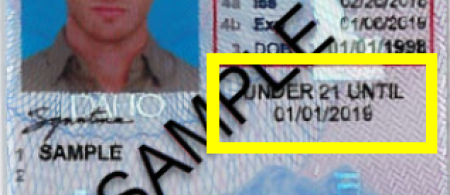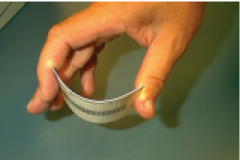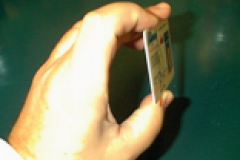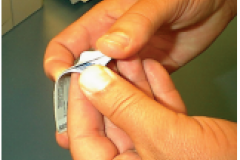Idaho businesses that sell tobacco products must comply with Idaho's "Prevention of Minors' Access to Tobacco Products or Electronic Smoking Devices" law and must train employees about minors and tobacco and electronic smoking device products. By law, any employee who sells tobacco or electronic smoking device products must sign a Department of Health and Welfare form indicating that they understand the state law's requirements.
Training
Clerk/Retailer Training Materials
Employee Training Form
Driver's licenses
Idaho driver's licenses make it easy to see if someone is under 21. A vertical license means the person is under 21 and a horizontal license means the person is over 21.
Sample licenses


Other state ID examples
License fraud
There are three basic types of ID fraud: Borrowed, Fake, and Altered. Modern and enhanced security features have changed the way that ID fraud occurs. Borrowed IDs are by far the most common method of ID fraud, followed by Fake IDs, and more rarely Altered IDs. Here are some of the ways you can spot problems.
Borrowed IDs are now the most common form of ID fraud. It is estimated that 95% of all ID fraud originates with a borrowed ID. Minors get borrowed IDs from several sources: they use the ID of an older sibling, an older friend, or get an ID of a stranger through their friends and friend networks.
Here are some suggestions for spotting the borrowed ID:
- Compare the photograph on the ID with the person standing in front of you and question discrepancies (the cardholder counts on the fact that a store clerk will be too busy to inspect the ID closely).
- Review and compare other physical descriptors like height and weight.
- Look for signs of duplicate cards, such as "DUPL" stamp.
- Watch for expired cards.
- Ask questions!
- Ask the cardholder to verify personal data on the card.
- Obtain a signature and compare it to the one on the card.
- Ask the cardholder what their middle initial stands for.
- Purposely mispronounce their name or misstate their middle initial to see if the cardholder instinctively gives the correct information.
- Look for signs of deceit.
- Does the cardholder avoid eye contact, exhibit unusual hesitation when answering, behave nervously, attempt to intimidate, or do their eyes track upwards (as if to recall or make something up)?
In an effort to keep up with the modern security enhancements of real IDs, manufacturers of faked IDs are using advanced technology to create very "real" looking fakes. The internet has become a prime resource to purchase these IDs. The best way to spot fakes is to do a visual and physical examination of the ID in question, and to be familiar with what a real ID in your community looks like.
- Physical inspection of the ID.
- Check the card's rigidity. A fake ID will often have different weight and/or thickness of a real ID. Gently squeeze the ID to determine if the card feels right.

- Check the card's edges. Almost all IDs have rounded edges around the entire ID. If the edges feel square it is possible the card has a false front.

- Check and feel the front and back of the ID. Feel for bumps, ridges and irregularities.
- Check the IDs corners. A real IDs corners cannot be split or peeled back. If you can peel back or split the IDs corners with your nail, it is likely a fake ID.

- Check the card's rigidity. A fake ID will often have different weight and/or thickness of a real ID. Gently squeeze the ID to determine if the card feels right.
- Visual inspection of the ID.
- Do a general visual examination of the overall appearance, fonts and coloration patterns, and look for any known security features that should be present on valid IDs.
- Don't forget to examine the back of the ID. Creators of fake IDs take great care to replicate the front of the ID but put less effort into the back.
- Know what Idaho's licenses look like.
- Become familiar with both the look and feel of Idaho's adult and minor IDs, including all of the security features that are present on real IDs. Check out Idaho's License Designs for more information.
Modern IDs are much harder to alter than in the past. For example, given the advancement of ID printing methods and the use of specialized plastic material, altering an IDs photo is extremely difficult as is rarely seen on newer forms of ID. The most common technique to alter IDs is to use clear fingernail polish or superglue and write or print new dates on top of the polish or glue. So to spot altered IDs look for the following:
- Check for small raised spots or small shiny spots over the date of birth or "Under Until" dates.
- Check for changes in font or coloration